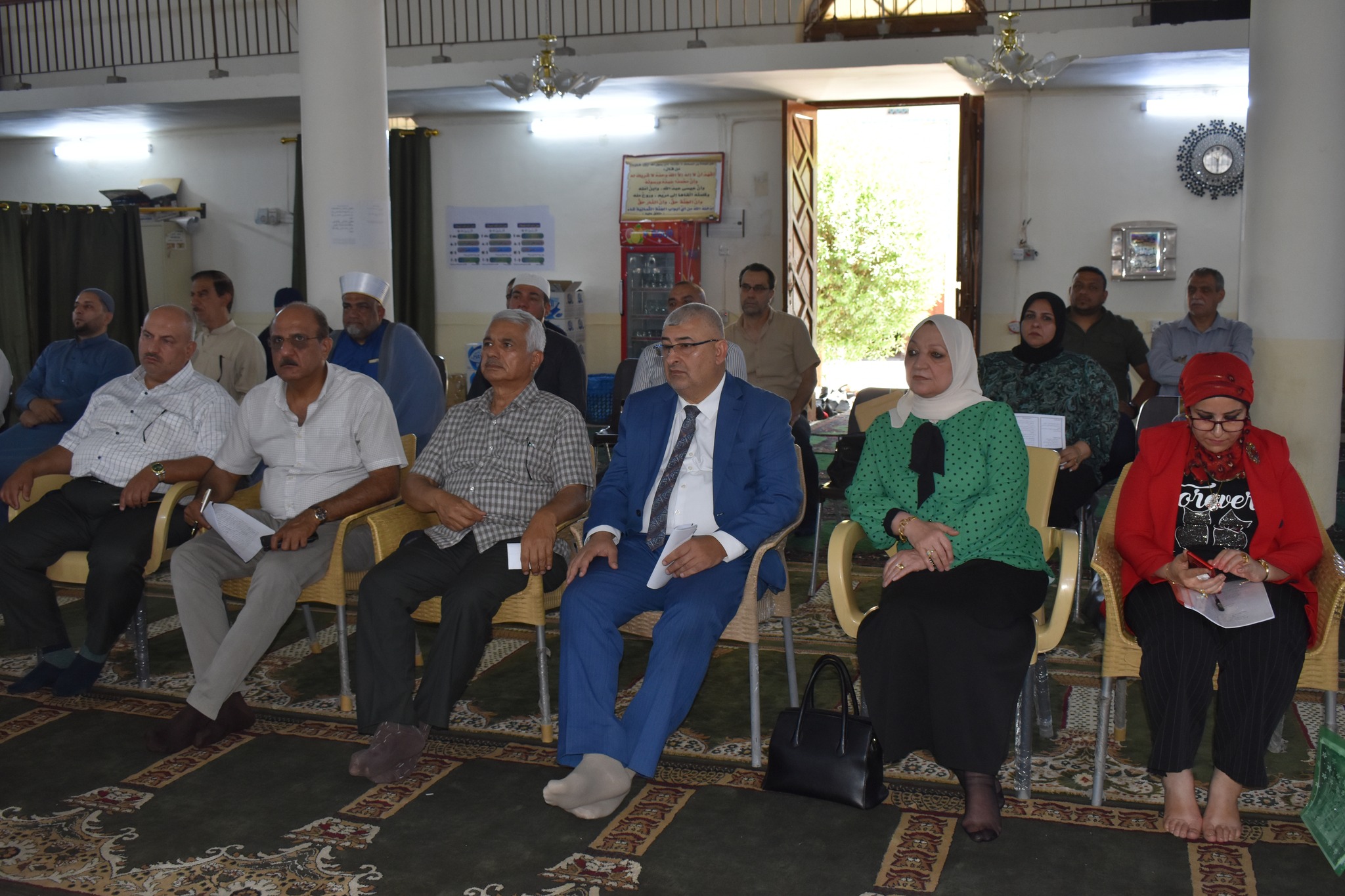مركز احياء التراث العلمي العربي
تاريخ جامع الوزير وعمارته History and architecture of the Minister's Mosqueندوة
by
→
Asia/Baghdad
قاعه د نبيله داود (مركز احياء التراث العلمي العربي )
قاعه د نبيله داود
مركز احياء التراث العلمي العربي
بغداد
Description
ندوة علمية
برعاية السيد رئيس جامعة بغداد الاستاذ الدكتور بهاء ابراهيم انصاف المحترم و بإشـراف الاستـاذ الدكتـورة الاء نافـع جـاسم مـديرة المركز نظم مركز احياء التراث العلمي العربي في جامعة بغداد وبالتعاون مع ديوان الوقف السني صباح الاثنين الموافق ٢٠٢٤/٦/٣ الندوة علمية الموسومة (تاريخ جامع الوزير وعمارته) افتتحت الندوة بتلاوة عطرة من الذكر الحكيم وقراءة سورة الفاتحة على ارواح شهداء العراق ثم كلمة الدكتور عباس عبدالستار جاسم السعدي معاون مدير اوقاف بغداد/ الرصافة متحدثاً عن اهمية المساجد في التاريخ الاسلامي وان اول من بنى مسجداً هو الرسول الله (صل الله عليه واله وسلم ) ولم تقتصر تلك المساجد للعبادة فقط انما كانت لنشر العلوم المختلفة وكذلك مكانتها كمقر لقيادة الدولة.
والقيت في الندوة عدة بحوث منها بحث ا.د. سعدي ابراهيم الدراجي (تخطيط جامع الوزير وعمارته) تحدث الباحث عن تخطيط جامع الاول الذي انشأه الوزير حسن باشا عام ١٥٩٩م – ١٠٠٨هـ. وكان التخطيط عبارة عن بيت صلاة سقف بقبة واحدة . ثم جدد في القرن السابع عشر ميلادي واصبح يتكون من بيت صلاة مسقف علية ثلاث قباب اكبرها الوسطى. وبحث ا.م.د. وسن حسين محيميد (جامع الوزير في روايات المؤرخين) متحدثة عن جامع الوزير من جوامع بغداد القديمة الواقعة بالجانب الشرقي منها وتحديداً في سوق السراي مطل على نهر دجلة يعود تاريخ انشائه إلى العصر العباسي. وكان يسمى بجامع ذي المنارة. اشار عبد الحميد عبادة في كتابه الضوء اللامع بأثار بغداد والمساجد والجوامع أن الوزير(الوالي) حسن باشا بن محمد باشا قد انشأه وبناه سنة ١٠٠٨للهجرة . وتاريخ بناؤه يعود الى قصة من نسيج الموروث الشعبي من ان هناك زوارق تحمل تجارة قد غرقت واختلطت البضائع مع بعضها فرفع التجار ماحل بهم للوالي حسن باشا الذي اشار عليهم ببيع التجارة وبناء جامع في مكان غرق زوارقهم. وبحث المشترك م.د. مازن قاسم مهلهل وأ.م.د. رشا عيسى فارس (مدرسة جامع الوزير) تحدث عن مدرسة جامع الوزير معلم تأريخي يعود الى الحقبة العثمانية تم تأسيسها في القرن السابع عشر الميلادي هذا المعلم التاريخي يعكس الطراز المعماري الاسلامي الفريد الذي كان سائداً في تلك الفترة .تأسست المدرسة في عام ١٠٧١هـ / ١٦٦٠م تم بناؤها بأمر من الوزير العثماني حسين باشا ومن هنا جاء اسمها (( مدرسة جامع الوزير )) اذ أهتم الوزير ببناء العديد من المنشآت العامة بما في ذلك المساجد والمدارس والخانات التي خدمت وساهمت في تحسين البنية التحتية للمدينة ، فكانت الغاية من أنشائها تقديم تعليم ديني متقدم بالإضافة الى العلوم الاخرى وفقاً لما أورده المؤرخ العثماني( أحمد جودت باشا ) فأن المدرسة أشاءة بهدف توفير تعليم عالي المستوى لأبناء النخبة والعامة على حد سواء وفي الختام تحدث الدكتور محمد خزعل محمود عن جامع الوزير وهو من الجوامع العثمانية تأسس سنة ١٦٦٠م وقد تعاقب فيه الشيوخ والعلماء على مدار ثلاثة قرون ونصف تقريباً الى ان ختم بإمامة الشيخ خزعل الدليمي النقشبندي والذي كان له دور بارز في عمارة المسجد من حيث اقامة الصلوات الخمسة والمناسبات الدينية.
Under the patronage of the Honorable President of the University of Baghdad, Professor Dr. Bahaa Ibrahim Ansaf, and under the supervision of Professor Dr. Alaa Nafi Jassim, the respected Director of the Center, the Center for the Revival of Arab Scientific Heritage at the University of Baghdad, in cooperation with the Sunni Endowment Office, organized the symposium on Monday morning, 6/3/2024. Scientific tagged (the history of Al-Wazir Mosque and its architecture). The symposium opened with a fragrant recitation of the Holy Quran and the reading of Surat Al-Fatihah for the souls of the martyrs of Iraq, then a speech by Dr. Abbas Abdel Sattar Jassim Al-Saadi, Assistant Director of the Baghdad Endowments/Al-Rusafa. Speaking about the importance of mosques in Islamic history, and that the first person to build a mosque was the Messenger of God (may God bless him and his family and grant them peace). These mosques were not limited to worship only, but rather were for the dissemination of various sciences, as well as their status as the headquarters of the state’s leadership. Several research papers were presented at the symposium, including the research of Prof. Dr. Saadi Ibrahim Al-Daraji (planning and architecture of the Wazir Mosque) The researcher talked about the layout of the First Mosque, which was established by Minister Hassan Pasha in 1599 AD – 1008 AH. The plan was a house of prayer with a single dome roof. Then it was renewed in the seventeenth century AD and became a house of prayer with a three-domed roof And the research of A.M.D. Wasan Hussein Muhaymid (Al-Wazir Mosque in the historians’ narratives) is talking about Al-Wazir Mosque, which is one of the mosques of ancient Baghdad, located on the eastern side of it, specifically in the Saray Market, overlooking the Tigris River. Its construction dates back to the Abbasid era. It was called Dhul-Manara Mosque bdul Hamid’s reference in his book The Brilliant Light to the antiquities of Baghdad, the mosques and mosques, and that the Minister (Wali) Hassan Pasha bin Muhammad Pasha established and built it in the year 1008 AH. The history of its construction goes back to a story that is woven into popular heritage, that there were boats carrying trade that sank and the goods were mixed together, so the merchants presented their situation to the governor, Hassan Pasha, who advised them to sell the trade and build a mosque in the place where their boats sank.
The joint research, M.D. Mazen Qasim Muhalhal and A.M.D. Rasha Issa Fares (Al-Wazir Mosque School) talked about the Al-Wazir Mosque School, which is a historical landmark dating back to the Ottoman era. It was established in the seventeenth century AD. This historical landmark reflects the unique Islamic architectural style that was prevalent in that period. The school was founded In the year 1071 AH / 1660 AD, it was built by order of the Ottoman Minister Hussein Pasha, and from here came its name ((Al-Wazir Mosque School)) as the minister was interested in building many public facilities, including mosques, schools, and khans that served and contributed to improving the city’s infrastructure. The purpose of its establishment was to provide advanced religious education in addition to other sciences, according to what was reported by the Ottoman historian (Ahmed Cevdet Pasha).
In conclusion, Dr. Muhammad Khazal Mahmoud spoke about the Wazir Mosque, which is one of the Ottoman mosques and was founded in 1660 AD. Sheikhs and scholars alternated there over the course of approximately three and a half centuries until it was concluded with the imamate of Sheikh Khazal al-Dulaimi al-Naqshbandi, who had a prominent role in the architecture of the mosque in terms of Establishing the five daily prayers and religious events

Organised by
ندوة خارج الخطة
Contact


